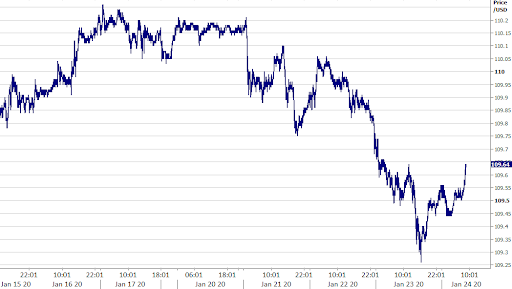Investors flock to safe-havens as coronavirus spreads
- Go back to blog home
- Latest
Investors continued to favour the safe-haven currencies on Thursday, with news of spreading in China’s coronavirus causing the market to fret about its potential economic impact.
So far, the reaction in the currency markets has not translated into a full-blown panic – the USD/JPY cross has fallen by no more than around three-quarters of a percent this week. The situation is, however, expected to worsen before it gets better. Should the number of casualties and reported cases outside of China begin to rise, then we may start seeing a more aggressive downward move in the USD/JPY pair towards the 109 level.
Figure 1: USD/JPY (15/01 – 24/01)
Friday’s PMI data holds key to BoE rate cut
In the UK, attention in financial markets will be squarely on this morning’s business activity PMI data, which will take on more importance than usual.
Following a string of soft data and dovish comments from a handful of MPC members, investors are now placing around a 60% chance of a rate cut when the BoE meets next Thursday. We think that the vote on rates will be very close, with this morning’s PMI release maybe tipping the balance one way or another. Should the removal of the Brexit and election uncertainty be reflected in a significant way in Friday’s services index, i.e. a reading north of the 51.5 or so level, then we think this would provide enough justification for policymakers to hold off from cutting rates when it meets next week. By contrast, another disappointing reading below consensus may cement the case for a cut.
Euro falls on Lagarde’s perceived dovish tone
Yesterday’s European Central Bank meeting came and went without any real fireworks or important announcements to note.
President Lagarde struck an optimistic tone on Euro Area inflation, saying that there were ‘some signs of moderate increase in underlying inflation’. She did, however, fall short of the rather lofty market expectations by repeating the line that risks to Eurozone growth were ‘tilted to the downside’. Given the recent improvements in macroeconomic data out of the bloc, investors likely went into the meeting expecting a much more hawkish tilt than Lagarde actually delivered, which is probably behind much of the sell-off.
This morning’s Euro Area PMI data (not yet released at the time of writing) could shift the common currency today. Following the much better-than-expected German PMI data, a surprise to the upside in the Euro-wide number looks on the cards. This would further support our view that the European economy is more likely than not to accelerate as we move deeper into 2020.


